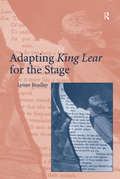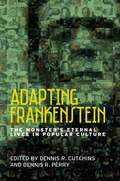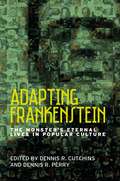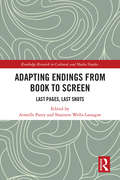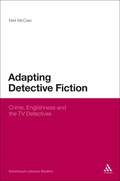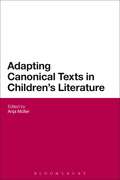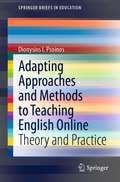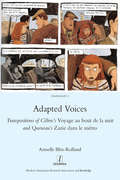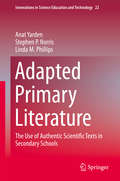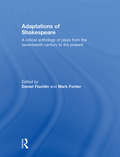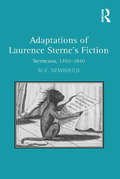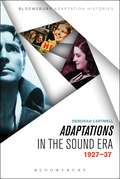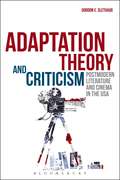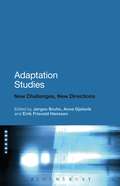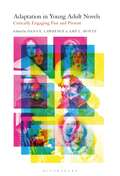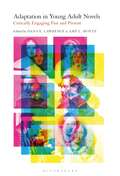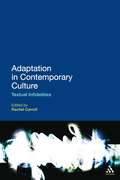- Table View
- List View
Adapting King Lear for the Stage
by Lynne BradleyQuestioning whether the impulse to adapt Shakespeare has changed over time, Lynne Bradley argues for restoring a sense of historicity to the study of adaptation. Bradley compares Nahum Tate's History of King Lear (1681), adaptations by David Garrick in the mid-eighteenth century, and nineteenth-century Shakespeare burlesques to twentieth-century theatrical rewritings of King Lear, and suggests latter-day adaptations should be viewed as a unique genre that allows playwrights to express modern subject positions with regard to their literary heritage while also participating in broader debates about art and society. In identifying and relocating different adaptive gestures within this historical framework, Bradley explores the link between the critical and the creative in the history of Shakespearean adaptation. Focusing on works such as Gordon Bottomley's King Lear's Wife (1913), Edward Bond's Lear (1971), Howard Barker's Seven Lears (1989), and the Women's Theatre Group's Lear's Daughters (1987), Bradley theorizes that modern rewritings of Shakespeare constitute a new type of textual interaction based on a simultaneous double-gesture of collaboration and rejection. She suggests that this new interaction provides constituent groups, such as the feminist collective who wrote Lear's Daughters, a strategy to acknowledge their debt to Shakespeare while writing against the traditional and negative representations of femininity they see reflected in his plays.
Adapting Frankenstein: The monster's eternal lives in popular culture
by Maria Bachman Paul PetersonMary Shelley’s Frankenstein is one of the most popular novels in western literature. It has been adapted and re-assembled in countless forms, from Hammer Horror films to young-adult books and bandes dessinées. Beginning with the idea of the ‘Frankenstein Complex’, this edited collection provides a series of creative readings that explore the elaborate intertextual networks that make up the novel’s remarkable afterlife. It broadens the scope of research on Frankenstein while deepening our understanding of a text that, 200 years after its original publication, continues to intrigue and terrify us in new and unexpected ways.
Adapting Frankenstein: The monster's eternal lives in popular culture
by Dennis R. Perry Dennis R. CutchinsMary Shelley’s Frankenstein is one of the most popular novels in western literature. It has been adapted and re-assembled in countless forms, from Hammer Horror films to young-adult books and bandes dessinées. Beginning with the idea of the ‘Frankenstein Complex’, this edited collection provides a series of creative readings that explore the elaborate intertextual networks that make up the novel’s remarkable afterlife. It broadens the scope of research on Frankenstein while deepening our understanding of a text that, 200 years after its original publication, continues to intrigue and terrify us in new and unexpected ways.
Adapting Endings from Book to Screen: Last Pages, Last Shots (Routledge Research in Cultural and Media Studies)
by Armelle Parey Shannon Wells-LassagneThis book offers a new perspective on adaptation of books to the screen; by focusing on endings, new light is shed on this key facet of film and television studies. The authors look at a broad range of case studies from different genres, eras, countries and formats to analyse literary and cinematic traditions, technical considerations and ideological issues involved in film and television adaptions. The investigation covers both the ideological implications of changes made in adapting the final pages to the screen, as well as the aesthetic stance taken in modifying (or on the contrary, maintaining) the ending of the source text. By including writings on both film and television adaptations, this book examines the array of possibilities for the closure of an adapted narrative, focusing both on the specificities of film and different television forms (miniseries and ongoing television narratives) and at the same time suggesting the commonalities of these audiovisual forms in their closing moments. Adapting Endings from Book to Screen will be of interest to all scholars working in media studies, film and television studies, and adaptation studies.
Adapting Endings from Book to Screen: Last Pages, Last Shots (Routledge Research in Cultural and Media Studies)
by Shannon Wells-Lassagne Armelle PareyThis book offers a new perspective on adaptation of books to the screen; by focusing on endings, new light is shed on this key facet of film and television studies. The authors look at a broad range of case studies from different genres, eras, countries and formats to analyse literary and cinematic traditions, technical considerations and ideological issues involved in film and television adaptions. The investigation covers both the ideological implications of changes made in adapting the final pages to the screen, as well as the aesthetic stance taken in modifying (or on the contrary, maintaining) the ending of the source text. By including writings on both film and television adaptations, this book examines the array of possibilities for the closure of an adapted narrative, focusing both on the specificities of film and different television forms (miniseries and ongoing television narratives) and at the same time suggesting the commonalities of these audiovisual forms in their closing moments. Adapting Endings from Book to Screen will be of interest to all scholars working in media studies, film and television studies, and adaptation studies.
Adapting Detective Fiction: Crime, Englishness and the TV Detectives
by Neil McCawAdapting Detective Fiction is a study of specific instances of adaptation, with close readings of both the originating sources and adapted texts. But it is also more than this. It is a study of the politics of representation in the last decades of the twentieth century, and the role television detective fiction plays in this. It is about the mutually-informing interrelation of cultural texts and political rhetoric, about the connection between the popular-cultural depiction of crime and criminality and how we come to understand human behaviour and culpability; most of all, it is a detailed consideration of what the process of adaptation reveals about the shifting nature of the world in which we live. With specific reference to television series such as The Adventures of Sherlock Holmes, Miss Marple, Inspector Morse, A Touch of Frost, Cadfael, and Midsomer Murders, Adapting Detective Fiction uses adaptation as the basis for an exercise in later twentieth-century cultural history, illustrating the fundamental role detective fictions play in popular beliefs about the nature of crime and Englishness.
Adapting Canonical Texts in Children's Literature
by Anja MüllerAdaptations of canonical texts have played an important role throughout the history of children's literature and have been seen as an active and vital contributing force in establishing a common ground for intercultural communication across generations and borders. This collection analyses different examples of adapting canonical texts in or for children's literature encompassing adaptations of English classics for children and young adult readers and intercultural adaptations of children's classics across Europe. The international contributors assess both historical and transcultural adaptation in relation to historically and regionally contingent concepts of childhood. By assessing how texts move across age-specific or national borders, they examine the traces of a common literary and cultural heritage in European children's literature.
Adapting Canonical Texts in Children's Literature
by Anja MüllerAdaptations of canonical texts have played an important role throughout the history of children's literature and have been seen as an active and vital contributing force in establishing a common ground for intercultural communication across generations and borders. This collection analyses different examples of adapting canonical texts in or for children's literature encompassing adaptations of English classics for children and young adult readers and intercultural adaptations of children's classics across Europe. The international contributors assess both historical and transcultural adaptation in relation to historically and regionally contingent concepts of childhood. By assessing how texts move across age-specific or national borders, they examine the traces of a common literary and cultural heritage in European children's literature.
Adapting Approaches and Methods to Teaching English Online: Theory and Practice (SpringerBriefs in Education)
by Dionysios I. PsoinosThis book provides a framework for synchronous and asynchronous online language teaching. It elaborates on the key features of an online teaching setting, including the instructional media that are involved in it, their affordances and limitations, and recommends ways to adapt pedagogy to suit the online environment. To this end, the book draws on well-established language teaching methods that have been widely used in the physical classroom and puts them to the test by applying them online. This results in the emergence of an e-clectic approach that enables language teachers to be flexible and intentional in their online classroom-related decisions and combines good practices that cut across the broader methodological spectrum with personal teaching preferences, teaching style, and stakeholders’ specifications always considering the capabilities of the setting and the tools currently available to teachers and learners. The book enables teachers to be critical and reflective of their own online teaching practices and equips them, via analysis of live online language sessions, with the necessary skills to confidently engage with screen layout. It also addresses the prominent issue of adapting teacher and learner identity in the online context, and examines their respective roles in online language sessions in a holistic way, offering guidance and support for the practicing online language teacher.
Adapted Voices
by Armelle Blin-RollandVoyage au bout de la nuit (1932), by Louis-Ferdinand Celine (1894-1961), and Zazie dans le metro (1959), by Raymond Queneau (1903-1976), were two revolutionary novels in their transposition of spoken language into written language. Since their publication they have been adapted into a broad range of media, including illustrated novel, bande dessinee, film, stage performance and recorded reading. What happens to their striking literary voices as they are transposed into media that combine text and image, sound and image, or consist of sound alone? In this study, Armelle Blin-Rolland examines adaptations sparked by these two seminal novels to understand what 'voice' means in each medium, and its importance in the process of adaptation.
Adapted Voices
by Armelle Blin-RollandVoyage au bout de la nuit (1932), by Louis-Ferdinand Celine (1894-1961), and Zazie dans le metro (1959), by Raymond Queneau (1903-1976), were two revolutionary novels in their transposition of spoken language into written language. Since their publication they have been adapted into a broad range of media, including illustrated novel, bande dessinee, film, stage performance and recorded reading. What happens to their striking literary voices as they are transposed into media that combine text and image, sound and image, or consist of sound alone? In this study, Armelle Blin-Rolland examines adaptations sparked by these two seminal novels to understand what 'voice' means in each medium, and its importance in the process of adaptation.
Adapted Primary Literature: The Use of Authentic Scientific Texts in Secondary Schools (Innovations in Science Education and Technology #22)
by Anat Yarden Stephen P. Norris Linda M. PhillipsThis book specifies the foundation for Adapted Primary Literature (APL), a novel text genre that enables the learning and teaching of science using research articles that were adapted to the knowledge level of high-school students. More than 50 years ago, J.J. Schwab suggested that Primary Scientific Articles “afford the most authentic, unretouched specimens of enquiry that we can obtain” and raised for the first time the idea that such articles can be used for “enquiry into enquiry”. This book, the first to be published on this topic, presents the realization of this vision and shows how the reading and writing of scientific articles can be used for inquiry learning and teaching. It provides the origins and theory of APL and examines the concept and its importance. It outlines a detailed description of creating and using APL and provides examples for the use of the enactment of APL in classes, as well as descriptions of possible future prospects for the implementation of APL. Altogether, the book lays the foundations for the use of this authentic text genre for the learning and teaching of science in secondary schools.
Adaptations of Shakespeare: An Anthology of Plays from the 17th Century to the Present
by Daniel Fischlin Mark FortierShakespeare's plays have been adapted or rewritten in various, often surprising, ways since the seventeenth century. This groundbreaking anthology brings together twelve theatrical adaptations of Shakespeares work from around the world and across the centuries. The plays includeThe Woman's Prize or the Tamer Tamed John FletcherThe History of King Lear Nahum TateKing Stephen: A Fragment of a Tragedy John KeatsThe Public (El P(blico) Federico Garcia LorcaThe Resistible Rise of Arturo Ui Bertolt BrechtuMabatha Welcome MsomiMeasure for Measure Charles MarowitzHamletmachine Heiner MüllerLears Daughters The Womens Theatre Group & Elaine FeinsteinDesdemona: A Play About a Handkerchief Paula VogelThis Islands Mine Philip OsmentHarlem Duet Djanet SearsEach play is introduced by a concise, informative introduction with suggestions for further reading. The collection is prefaced by a detailed General Introduction, which offers an invaluable examination of issues related to
Adaptations of Shakespeare: An Anthology of Plays from the 17th Century to the Present
by Daniel Fischlin Mark FortierShakespeare's plays have been adapted or rewritten in various, often surprising, ways since the seventeenth century. This groundbreaking anthology brings together twelve theatrical adaptations of Shakespeares work from around the world and across the centuries. The plays includeThe Woman's Prize or the Tamer Tamed John FletcherThe History of King Lear Nahum TateKing Stephen: A Fragment of a Tragedy John KeatsThe Public (El P(blico) Federico Garcia LorcaThe Resistible Rise of Arturo Ui Bertolt BrechtuMabatha Welcome MsomiMeasure for Measure Charles MarowitzHamletmachine Heiner MüllerLears Daughters The Womens Theatre Group & Elaine FeinsteinDesdemona: A Play About a Handkerchief Paula VogelThis Islands Mine Philip OsmentHarlem Duet Djanet SearsEach play is introduced by a concise, informative introduction with suggestions for further reading. The collection is prefaced by a detailed General Introduction, which offers an invaluable examination of issues related to
Adaptations of Laurence Sterne's Fiction: Sterneana, 1760–1840
by Mary-Celine NewbouldExploring how readers received and responded to literary works in the long eighteenth century, M-C. Newbould focuses on the role played by Laurence Sterne’s fiction and its adaptations. Literary adaptation flourished throughout the eighteenth century, encouraging an interactive relationship between writers, readers, and artists when well-known works were transformed into new forms across a variety of media. Laurence Sterne offers a particularly dynamic subject: the immense interest provoked by The Life and Opinions of Tristram Shandy, Gentleman and A Sentimental Journey through France and Italy inspired an unrivalled number and range of adaptations from their initial publication onwards. In placing her examination of Sterneana within the context of its production, Newbould demonstrates how literary adaptation operates across generic and formal boundaries. She breaks new ground by bringing together several potentially disparate aspects of Sterneana belonging to areas of literary studies that include drama, music, travel writing, sentimental fiction and the visual. Her study is a vital resource for Sterne scholars and for readers generally interested in cultural productivity in this period.
Adaptations of Laurence Sterne's Fiction: Sterneana, 1760–1840
by Mary-Celine NewbouldExploring how readers received and responded to literary works in the long eighteenth century, M-C. Newbould focuses on the role played by Laurence Sterne’s fiction and its adaptations. Literary adaptation flourished throughout the eighteenth century, encouraging an interactive relationship between writers, readers, and artists when well-known works were transformed into new forms across a variety of media. Laurence Sterne offers a particularly dynamic subject: the immense interest provoked by The Life and Opinions of Tristram Shandy, Gentleman and A Sentimental Journey through France and Italy inspired an unrivalled number and range of adaptations from their initial publication onwards. In placing her examination of Sterneana within the context of its production, Newbould demonstrates how literary adaptation operates across generic and formal boundaries. She breaks new ground by bringing together several potentially disparate aspects of Sterneana belonging to areas of literary studies that include drama, music, travel writing, sentimental fiction and the visual. Her study is a vital resource for Sterne scholars and for readers generally interested in cultural productivity in this period.
Adaptations in the Sound Era: 1927-37 (Bloomsbury Adaptation Histories)
by Deborah CartmellThere is no disputing that the coming of sound heralded a new era for adaptations. We take it for granted today that a film is enhanced by sound but it was not a view unanimously held in the early period of sound cinema. While there was a substantial degree of skepticism in the late 1920s and early 30s about the advantages of sound, what we would call technophobia today, the inclusion of speech in screen versions of literary and theatrical works, undeniably revised what it was to be an adaptation: words. Focusing on promotional materials, Adaptations in the Sound Era tracks early attempts to promote sound through the elevation of words in adaptations in the early sound period. The popular appeal of these films clearly stands in opposition to academic regard for them and the book reflects on the presence and marketing of 'words' in a variety of adaptations, from the introduction of sound in the late 1920s to the mid 1930s. This book contextualizes a range of adaptations in relation to debates about 'picturizations' of books in the early sound era, including reactions to the talking adaptation by writers such as, Irwin Panofsky, Aldous Huxley and Graham Greene. Film adaptations of Shakespeare, Dickens, gothic fiction and biopics are also discussed in relation to their use and promotion of sound or, more precisely, words.
Adaptations in the Sound Era: 1927-37 (Bloomsbury Adaptation Histories)
by Deborah CartmellThere is no disputing that the coming of sound heralded a new era for adaptations. We take it for granted today that a film is enhanced by sound but it was not a view unanimously held in the early period of sound cinema. While there was a substantial degree of skepticism in the late 1920s and early 30s about the advantages of sound, what we would call technophobia today, the inclusion of speech in screen versions of literary and theatrical works, undeniably revised what it was to be an adaptation: words. Focusing on promotional materials, Adaptations in the Sound Era tracks early attempts to promote sound through the elevation of words in adaptations in the early sound period. The popular appeal of these films clearly stands in opposition to academic regard for them and the book reflects on the presence and marketing of 'words' in a variety of adaptations, from the introduction of sound in the late 1920s to the mid 1930s. This book contextualizes a range of adaptations in relation to debates about 'picturizations' of books in the early sound era, including reactions to the talking adaptation by writers such as, Irwin Panofsky, Aldous Huxley and Graham Greene. Film adaptations of Shakespeare, Dickens, gothic fiction and biopics are also discussed in relation to their use and promotion of sound or, more precisely, words.
Adaptation Theory and Criticism: Postmodern Literature and Cinema in the USA
by Gordon E. SlethaugTraditional critics of film adaptation generally assumed a) that the written text is better than the film adaptation because the plot is more intricate and the language richer when pictorial images do not intrude; b) that films are better when particularly faithful to the original; c) that authors do not make good script writers and should not sully their imagination by writing film scripts; d) and often that American films lack the complexity of authored texts because they are sourced out of Hollywood. The 'faithfulness' view has by and large disappeared, and intertextuality is now a generally received notion, but the field still lacks studies with a postmodern methodology and lens.Exploring Hollywood feature films as well as small studio productions, Adaptation Theory and Criticism explores the intertextuality of a dozen films through a series of case studies introduced through discussions of postmodern methodology and practice. Providing the reader with informative background on theories of film adaptation as well as carefully articulated postmodern methodology and issues, Gordon Slethaug includes several case studies of major Hollywood productions and small studio films, some of which have been discussed before (Age of Innocence, Gangs of New York, and Do the Right Thing) and some that have received lesser consideration (Six Degrees of Separation, Smoke, Smoke Signals, Broken Flowers, and various Snow White narratives including Enchanted, Mirror Mirror, and Snow White and the Huntsman). Useful for both film and literary studies students, Adaptation Theory and Criticism cogently combines the existing scholarship and uses previous theories to engage readers to think about the current state of American literature and film.
Adaptation Theory and Criticism: Postmodern Literature and Cinema in the USA
by Gordon E. SlethaugTraditional critics of film adaptation generally assumed a) that the written text is better than the film adaptation because the plot is more intricate and the language richer when pictorial images do not intrude; b) that films are better when particularly faithful to the original; c) that authors do not make good script writers and should not sully their imagination by writing film scripts; d) and often that American films lack the complexity of authored texts because they are sourced out of Hollywood. The 'faithfulness' view has by and large disappeared, and intertextuality is now a generally received notion, but the field still lacks studies with a postmodern methodology and lens.Exploring Hollywood feature films as well as small studio productions, Adaptation Theory and Criticism explores the intertextuality of a dozen films through a series of case studies introduced through discussions of postmodern methodology and practice. Providing the reader with informative background on theories of film adaptation as well as carefully articulated postmodern methodology and issues, Gordon Slethaug includes several case studies of major Hollywood productions and small studio films, some of which have been discussed before (Age of Innocence, Gangs of New York, and Do the Right Thing) and some that have received lesser consideration (Six Degrees of Separation, Smoke, Smoke Signals, Broken Flowers, and various Snow White narratives including Enchanted, Mirror Mirror, and Snow White and the Huntsman). Useful for both film and literary studies students, Adaptation Theory and Criticism cogently combines the existing scholarship and uses previous theories to engage readers to think about the current state of American literature and film.
Adaptation Studies: New Challenges, New Directions
by Jorgen Bruhn Anne Gjelsvik Eirik Frisvold HanssenExtending the boundaries of contemporary adaptation studies, this book brings together leading international scholars to survey new directions in the field. Re-thinking the key questions at the heart of the discipline, Adaptation Studies: New Challenges, New Directions explores a wide range of perspectives and case studies in cross-media transformation. Topics covered include: * The history of adaptation studies * Theories of adaptation * Adaptations in film, literature, radio and historical sources * What is an 'original' text?
Adaptation Studies: New Challenges, New Directions
by Edited by Jørgen Bruhn, Anne Gjelsvik and Eirik Frisvold HanssenExtending the boundaries of contemporary adaptation studies, this book brings together leading international scholars to survey new directions in the field. Re-thinking the key questions at the heart of the discipline, Adaptation Studies: New Challenges, New Directions explores a wide range of perspectives and case studies in cross-media transformation. Topics covered include: * The history of adaptation studies * Theories of adaptation * Adaptations in film, literature, radio and historical sources * What is an 'original' text?
Adaptation in Young Adult Novels: Critically Engaging Past and Present
by Dana E. Lawrence and Amy L. MontzAdaptation in Young Adult Novels argues that adapting classic and canonical literature and historical places engages young adult readers with their cultural past and encourages them to see how that past can be rewritten. The textual afterlives of classic texts raise questions for new readers: What can be changed? What benefits from change? How can you, too, be agents of change?The contributors to this volume draw on a wide range of contemporary novels – from Rick Riordan's Percy Jackson series and Megan Shepherd's Madman's Daughter trilogy to Jesmyn Ward's Salvage the Bones – adapted from mythology, fairy tales, historical places, and the literary classics of Shakespeare, Charles Dickens, Jane Austen, and F. Scott Fitzgerald, among others. Unpacking the new perspectives and critiques of gender, sexuality, and the cultural values of adolescents inherent to each adaptation, the essays in this volume make the case that literary adaptations are just as valuable as original works and demonstrate how the texts studied empower young readers to become more culturally, historically, and socially aware through the lens of literary diversity.
Adaptation in Young Adult Novels: Critically Engaging Past and Present
Adaptation in Young Adult Novels argues that adapting classic and canonical literature and historical places engages young adult readers with their cultural past and encourages them to see how that past can be rewritten. The textual afterlives of classic texts raise questions for new readers: What can be changed? What benefits from change? How can you, too, be agents of change?The contributors to this volume draw on a wide range of contemporary novels – from Rick Riordan's Percy Jackson series and Megan Shepherd's Madman's Daughter trilogy to Jesmyn Ward's Salvage the Bones – adapted from mythology, fairy tales, historical places, and the literary classics of Shakespeare, Charles Dickens, Jane Austen, and F. Scott Fitzgerald, among others. Unpacking the new perspectives and critiques of gender, sexuality, and the cultural values of adolescents inherent to each adaptation, the essays in this volume make the case that literary adaptations are just as valuable as original works and demonstrate how the texts studied empower young readers to become more culturally, historically, and socially aware through the lens of literary diversity.
Adaptation in Contemporary Culture: Textual Infidelities
by Rachel CarrollAdaptation in Contemporary Culture: Textual Infidelities seeks to reconfigure the ways in which adaptation is conceptualised by considering adaptation within an extended range of generic, critical and theoretical contexts. This collection explores literary, film, television and other visual texts both as 'origins' and 'adaptations' and offers new insights into the construction of genres, canons and 'classics'. Chapters investigate both 'classic' and contemporary texts by British and American authors, from Jane Austen, Edgar Allen Poe and Charles Dickens to Bret Easton Ellis, P.D James and Sarah Waters. A diverse range of literary, film and television genres is examined, from romance to science fiction, the Western to the 'women's picture' and the heritage film to postmodern pastiche. With a thematic focus on key critical paradigms for adaptation studies - fidelity, intertextuality, historicity and authorship - this collection expands the field of adaptation studies beyond its conventional focus on 'page to screen' adaptations to include film remakes, video games, biopics, fan fiction and celebrity culture.
